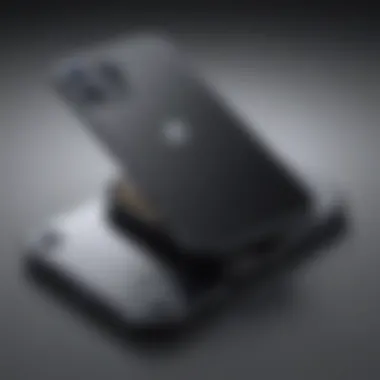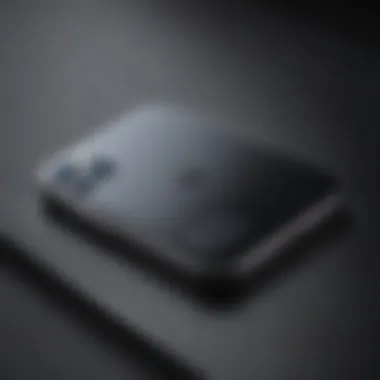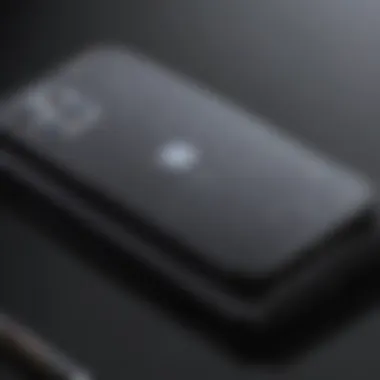Understanding the Weight of the iPhone 13 Pro Max


Intro
The iPhone 13 Pro Max has garnered considerable attention since its release. As Apple’s flagship device, it embodies a unique blend of performance and design. However, one aspect that often resurfaces in discussions is the weight of the device. This article will offer a deep dive into the weight of the iPhone 13 Pro Max, examining how it affects user experience, device performance, and market perception.
Understanding the intricacies surrounding the weight of this smartphone can greatly inform both enthusiasts and potential buyers. The aim is to unravel how both design choices and materials contribute to the overall experience of using this device.
Product Overview
The iPhone 13 Pro Max features a sleek design with an emphasis on both aesthetics and functionality.
Key features include:
- A 6.7-inch Super Retina XDR display, providing vibrant color and outstanding sharpness.
- The A15 Bionic chip, which enhances speed and efficiency.
- A triple-camera system that supports Night mode and ProRAW capabilities.
- MagSafe technology for easy attachment of accessories.
Specifications:
- Weight: 238 grams (8.4 ounces)
- Dimensions: 160.8 x 78.1 x 7.65 mm
- Available storage options: 128 GB, 256 GB, 512 GB, and 1TB
When comparing the iPhone 13 Pro Max with its predecessor, the iPhone 12 Pro Max, there are minor adjustments in size and weight. The addition of revamped materials and increased battery life has made the newer model slightly heavier.
Performance and User Experience
Performance analysis of the iPhone 13 Pro Max reveals significant improvements in speed and multitasking capabilities. The A15 Bionic chip allows for resource-intensive applications and gaming without any lag.
In terms of battery life, the iPhone 13 Pro Max excels, supporting usage throughout the day with ease. Users have reported that multitasking is seamless and, in most cases, exceptionally smooth.
Feedback from users highlights a generally positive reception regarding the user interface. iOS offers a level of customization that appeals to many. However, some users have noted that app compatibility, while largely robust, can sometimes lag behind newer features introduced in updates.
Design and Build Quality
Design elements of the iPhone 13 Pro Max incorporate premium materials like surgical-grade stainless steel and textured matte glass. These choices not only enhance aesthetics but also improve durability.
The device's weight plays a role in how it feels in hand. While some users may prefer lighter devices, many appreciate the solid feel the weight provides.
Durability assessments reveal that the iPhone 13 Pro Max can withstand drops and scratches better than many of its counterparts.
Software and Updates
Apple's commitment to providing timely updates is notable. The iPhone 13 Pro Max comes with iOS 15, which includes various features like Focus mode and enhanced privacy settings.
App compatibility remains high, with most major applications supporting the latest features. The ease of user customization options allows for a more personalized experience, catering to different preferences and usage styles.
Price and Value Proposition
The iPhone 13 Pro Max starts at a significant price point, reflecting its high-end features and capabilities. Variants available cater to a broad spectrum of storage needs, allowing consumers some flexibility.
When evaluating the value for money, the performance and longevity of the device come into consideration. While the price may deter some, many feel justified based on the quality and experience offered compared to similar products in the market, such as Samsung Galaxy S21 Ultra.
"Apple products, while pricy, often justify the cost through their longevity and performance."
In summary, understanding the implications of the iPhone 13 Pro Max's weight is crucial. It alters user perception and interaction with the device, setting the stage for the discussions to come.
Prologue to the iPhone Pro Max
The iPhone 13 Pro Max represents a significant advancement in Apple's smartphone line. It is important to understand this device not only for its features but also for its weight. The weight of a smartphone affects its usability, handling, and overall experience for users. This article will explore various aspects of the iPhone 13 Pro Max, emphasizing how its design, materials, and ergonomics contribute to its weight.
Overview of Apple's Design Philosophy


Apple’s design philosophy focuses on the simplicity and functionality of its devices. When creating the iPhone 13 Pro Max, Apple aimed to merge aesthetics with performance. This philosophy is evident in the choice of materials. Each element was carefully selected to provide strength, elegance, and usability.
The design has to resonate with users; it should not only look good but also feel good in hand. The seamless integration of hardware and software is a crucial aspect of Apple’s approach. With the iPhone 13 Pro Max, the thickness and weight were optimized to ensure that the phone remains comfortable to hold.
Key Features of the iPhone Pro Max
The iPhone 13 Pro Max is packed with features that speak to its premium positioning:
- Display: The 6.7-inch Super Retina XDR display offers stunning visuals.
- Camera System: The pro camera system includes improved low-light performance, ideal for photography enthusiasts.
- Processor: The A15 Bionic chip is designed for efficiency and power, ensuring smooth performance.
- Battery Life: Extended battery life allows for all-day use, reducing concerns about daily charging.
Each of these features contributes to the overall experience. Understanding the weight of the device is essential to fully appreciate how these features are integrated and the impact they may have on daily usage.
Weight Specifications of the iPhone Pro Max
Understanding the weight specifications of the iPhone 13 Pro Max is essential for grasping how it fits into the broader context of today’s mobile technologies. The device's weight influences user experience, portability, and overall performance. Discussions surrounding weight often focus on how it impacts handling and usability. Whether it's slipping the phone into a pocket or holding it for extended periods, the weight matters. Users often consider weight in conjunction with other specs, such as battery life and build quality. These factors must be integrated into the overall assessment of what the iPhone 13 Pro Max offers.
Understanding Device Weight in Context
Device weight has various implications, especially in the realm of smartphones. The iPhone 13 Pro Max weighs approximately 238 grams, making it one of the heavier models in Apple's lineup. However, it is important to consider this weight relative to its features.
- Build Quality: A heavier device may suggest a more robust build. The materials used can contribute to both weight and durability.
- Battery Life: A heavier device can house a larger battery. This can lead to better battery life, something highly valued by users.
- User Comfort: The weight may impact how comfortable the device feels during extended use.
Overall, it is essential for users to think about why a device weighs what it does. Are the benefits worth the extra grams?
Exact Weight Measurements
The iPhone 13 Pro Max has an impressive set of specifications that accompany its weight. The exact weight is 238 grams (8.3 ounces). This measurement can differ slightly based on the model and configurations chosen. For example, models with more storage may have minimal changes in weight due to added internal components.
In context, let’s compare this with some of its main competitors:
- Samsung Galaxy S21 Ultra: 228 grams
- Google Pixel 6 Pro: 210 grams
While the iPhone 13 Pro Max might be heavier than these other models, the key discussions should revolve around how this weight impacts performance and user experience. Heavier does not mean worse; instead, it may enhance certain functional aspects that tech enthusiasts and general users alike can appreciate, such as durability and battery capacity.
Understanding the weight of the iPhone 13 Pro Max is critical for comprehending its design philosophy and user experience.
Materials Used in Construction
The materials utilized in the construction of the iPhone 13 Pro Max are vital to understanding its overall weight and performance. Apple has carefully selected materials that not only look and feel premium but also impact the device's durability and user experience. In this section, we will delve into the interplay between the various materials used and their significance on the device's weight.
Glass and Aluminum: A Balancing Act
The iPhone 13 Pro Max features a combination of glass and aluminum. The front and back of the device are made of Ceramic Shield glass, which offers improved durability over previous models. This glass is designed to resist scratches and drops, adding to the overall lifespan of the phone. The aluminum frame, known as aerospace-grade aluminum, plays a crucial role as well. It is lightweight yet strong, providing structural support without adding excessive weight.
The choice of these materials highlights Apple's commitment to achieving a balance between aesthetics and functionality. The glass surface gives a sleek appearance, while the aluminum adds a sturdy feel to the device. Together, they help maintain a weight that is manageable for everyday tasks, striking a fine balance for users who appreciate both design and usability.
Impact of Materials on Weight and Durability
When discussing the weight of the iPhone 13 Pro Max, consideration of the materials goes beyond mere numbers. The choice of glass and aluminum significantly influences the weight distribution within the device, which in turn affects how users interact with it.
The Ceramic Shield glass offers a light touch while ensuring robustness. However, this glass is heavier than typical plastic. Apple has effectively compensated for this by using lighter metals like aluminum. This mix ensures that the device remains under the preferred weight threshold.
Durability is another crucial aspect of material choice. Objects that are lightweight but fragile can create a poor user experience. The strength of the aluminum frame allows the phone to withstand daily wear and tear. Users can carry the device in their pockets or bags without fearing it will easily break. The fusion of weight and durability reflects a calculated approach to consumer technology.
"Material choices like glass and aluminum are transformative in mobile device design, affecting everything from weight to user satisfaction."
In summary, the materials used in the iPhone 13 Pro Max are pivotal in crafting a phone that is both weight-efficient and durable, making it an essential aspect of this comprehensive analysis.


Ergonomics of the iPhone Pro Max
Understanding the ergonomics of the iPhone 13 Pro Max is crucial for both users and manufacturers. Ergonomics refers to how comfortably and efficiently a device can be used. For a smartphone, this means assessing factors like weight distribution, grip, and overall usability. These elements are particularly important for devices with larger screens, such as the iPhone 13 Pro Max, which has specific dimensions and weight that can influence user experience.
In the iPhone 13 Pro Max, Apple aims for a design that not only showcases technology but also enhances the user's interaction. A well-balanced device contributes to the comfort of handling over prolonged periods. Users often hold their smartphones while reading, browsing, or texting. Therefore, understanding how weight affects hand fatigue, grip, and overall user satisfaction becomes essential.
Weight Distribution and User Comfort
Weight distribution plays a significant role in determining user comfort. The iPhone 13 Pro Max weighs 238 grams, which is noticeable, especially compared to other models. It is crucial to assess how this weight is distributed throughout the device.
- Center of Gravity: The design ensures that the weight is evenly distributed. This allows users to hold it comfortably with one hand. A device that feels heavy on one side can lead to awkward angles, making usage less enjoyable.
- Grip and Contour: The rounded edges of the iPhone 13 Pro Max also assist in comfort. The materials used offer a premium feel that aids grip, preventing accidental drops. A secure grip reduces the user's effort during prolonged use.
- User Adaption: Many users adapt to the weight. Some may find it heavy initially, but over time, their hands become used to the mass, showing that initial impressions can often be misguiding.
Real-World User Experience Feedback
The feedback from users about the iPhone 13 Pro Max's ergonomics provides insights into its real-world performance. Many users express satisfaction with how the phone fits within their daily routines.
"I used to struggle with using larger phones, but I find the iPhone 13 Pro Max manageable. It's hefty but feels right in my hand."
- Positive Feedback: Users report that the device's weight contributes to a feeling of durability. This aspect is appealing to many who believe a heavier device indicates a sturdier build.
- Negative Feedback: However, some users have mentioned fatigue during extended usage. Holding the device for long periods, like gaming or video streaming, may become tiring. While the weight can be comforting, it also poses challenges when users remain engaged for too long.
- Exceptions by Activity: Activities like photography or gaming showcase this balance. Many enjoy the stability offered by the weight when taking photos, appreciating how it reduces unintentional movements.
Overall, while the weight of the iPhone 13 Pro Max can be a disadvantage under some conditions, it is balanced out by its design, which enhances user experience. Understanding these factors allows potential buyers to consider how the device will work within their own lifestyle.
Comparative Analysis with Other Devices
A thorough comparative analysis with other devices provides valuable context for understanding the weight of the iPhone 13 Pro Max. It is essential to evaluate how this particular model stacks up against its competitors in the smartphone market. This analysis covers the nuances of device weight, material choices, and ergonomic design among similar devices, allowing tech enthusiasts to make informed decisions.
Weight Comparisons with Competitor Models
When assessing the iPhone 13 Pro Max, it is crucial to compare its weight with models from manufacturers like Samsung, Google, and OnePlus. For example, the Samsung Galaxy S21 Ultra weighs approximately 228 grams, while the Google Pixel 6 tops at about 207 grams. In contrast, the iPhone 13 Pro Max weighs 238 grams. Each device's weight affects not just portability but also the user's overall experience.
The differences in weight can be attributed to various design factors:
- Material Choices: Premium materials like glass and stainless steel may yield more substantial devices.
- Screen Size: Larger screens often translate to increased weight due to enhanced dimensions.
- Battery Capacity: Devices with higher battery capacity typically weigh more due to additional components.
This highlights that while the iPhone 13 Pro Max is heavier than some competitors, it is essential to consider how this weight contributes to the overall performance and experience of the phone.
Consumer Preferences in Device Weight
Consumer preferences regarding device weight are multifaceted and often varying among users. Studies reveal that while some consumers prefer lightweight smartphones for ease of carrying, others appreciate the heft of a more substantial device, associating it with sturdiness and durability. This presents an interesting dilemma for manufacturers:
- Lightweight Options: For users focused on portability, lighter devices are an attractive choice.
- Weightier Devices: Users who emphasize build quality may prefer a heavier model that feels more premium.
Surveys often indicate that a balanced weight contributes to better comfort during prolonged use. As technology advances, preferences evolve, influenced by usability, aesthetics, and the marketing strategies of prominent brands. Hence, a comprehensive understanding of consumer biases concerning weight significantly shapes future design decisions across the industry.
Technological Contributions to Weight Management
Understanding the weight of the iPhone 13 Pro Max leads us to examine the technological strides that have facilitated lighter and more efficient device design. Weight management is a critical aspect in modern smartphones. A well-designed phone needs to balance performance, functionality, and user comfort. In the case of the iPhone 13 Pro Max, Apple utilizes various technologies that contribute to this balance.
Advancements in Material Engineering
Material choices play a significant role in the weight of devices. For the iPhone 13 Pro Max, Apple uses high-grade materials designed not only for aesthetics but also for strength and weight reduction. One primary component is the ceramic shield on the front, which provides excellent durability while adding only a minimal amount to the total weight. The back is composed of textured matte glass that enhances grip without compromising on weight.
Moreover, the aluminum frame offers structural integrity while remaining lightweight. This careful selection of materials is informed by advancements in engineering practices, allowing for optimized production processes that align with user needs. With lighter materials, users can carry their devices without fatigue, enhancing overall usability.
Battery Technology and Its Influence on Weight
Battery technology is another crucial element affecting overall weight in devices. The iPhone 13 Pro Max is equipped with a lithium-ion battery, which is known for its high energy density. This type of battery allows for a longer lifespan and greater power output without adding significant weight to the device.


"The integration of advanced battery technology allows for enhanced performance without the cumbersome weight that typically comes with such power."
Apple has invested in improving battery efficiency, which not only benefits performance but also minimizes additional weight from other components that might be needed for power management. The result is a device that offers prolonged use without the weight penalty of earlier battery technologies.
Consumer Perception of Weight in Technology
Understanding how consumers perceive weight in mobile devices is essential for assessing user experience and satisfaction. In the case of the iPhone 13 Pro Max, weight is not just a technical specification; it informs user expectations and can influence purchase decisions. Given the device’s premium feel and design, its weight plays a crucial role in shaping how consumers interact with it. Balance, heft, and perceived durability are key factors that individuals consider.
The perception of weight also connects to functionality. A heavier device might suggest sturdiness or advanced technology, while a lighter model could imply convenience and portability. Users assess these attributes based on personal needs and preferences, creating a diverse landscape of opinions.
Psychological Impact of Device Weight
The psychological effects of device weight can be profound. A heavier phone can evoke feelings of reliability and quality, often associated with more premium devices. When users hold the iPhone 13 Pro Max, they may inherently attribute its weight to its advanced technology and superior craftsmanship.
Users often experience a sense of satisfaction from the weight of a premium product. This connection between weight and quality is not merely superficial; it aligns with broader societal tendencies of valuing heft in technological devices. For instance, studies have shown that users tend to associate heavier gadgets with positive characteristics such as durability and performance.
Conversely, some consumers might find excessive weight burdensome. Individuals who prioritize practicality and efficiency may hesitate to adopt devices that feel too heavy or cumbersome. This dichotomy illustrates the complex relationship between user expectation and experience, making weight a multidimensional aspect of user perception.
Trends in Consumer Preferences
The landscape of consumer preferences regarding device weight is constantly evolving. As mobile technology advances, so does the expectation for lighter devices without sacrificing performance. Recent trends indicate a growing preference for lightweight phones, especially among users who prioritize portability and versatility in their daily lives.
With the increasing popularity of mobile photography, many consumers are seeking devices that are easy to handle, especially during prolonged use. Lighter options are often favored for their convenience during casual use or travel. In contrast, users who engage heavily in gaming or productivity tasks may still appreciate the added weight for its perceived stability and comfort during extended sessions.
Observing the market, brands are adapting to these preferences by balancing innovation with traditional expectations. As consumers express their desires more vocally through social media and forums, manufacturers like Apple must remain alert to this feedback to stay competitive.
The psychological impact of weight, combined with evolving trends in consumer preferences, underscores the significant role of ergonomics in mobile device design.
The Future of Mobile Device Design
The future of mobile device design is an essential aspect to explore, especially when analyzing how weight impacts user experience and functionality. As smartphone technology evolves, manufacturers face the challenge of maintaining or reducing device weight while enhancing performance. This section will explore elements such as advancements in materials, improvements in battery technology, and consumer expectations.
Emerging Trends in Weight Reduction
In the quest to create lighter devices, several emerging trends are shaping the future of mobile design.
- Material Innovation: The utilization of lighter, more durable materials like carbon fiber and advanced polymers is on the rise. These materials offer robust protection without significant weight.
- Miniaturization: Engineers are continuously working to reduce the size of components, such as circuit boards and batteries. Techniques like 3D stacking and system-on-chip designs help minimize space and weight without sacrificing power.
- Streamlined Hardware: Manufacturers are developing integrated components to replace multiple parts. This not only reduces weight but also improves efficiency and performance.
- Flexible Displays: The advent of flexible OLED technology is enabling devices with thinner profiles. These displays not only deliver better visuals but also add minimal weight compared to traditional screens.
These trends reflect a significant shift towards minimalism in mobile designs, which is not only aesthetically pleasing but also prioritizes portability.
Sustainability Considerations in Device Weight
Sustainability is becoming a central theme in the technology landscape, especially regarding weight and materials used in devices. Several considerations play a crucial role:
- Material Sourcing: The choice of materials directly influences the environmental impact of device production. Using recyclable materials contributes to sustainability goals.
- Energy Efficiency: Lighter devices often require less energy to operate effectively. This connection between weight and efficiency can lead to longer battery life, which benefits both consumers and the environment.
- Lifecycle Management: Manufacturers are focusing on designs that allow for easier recycling and refurbishment of devices. A lighter design simplifies transportation and processing when a device reaches the end of its lifecycle.
- Consumer Awareness: Tech enthusiasts and general consumers are increasingly aware of the impact their choices have on the environment. They tend to favor brands that prioritize sustainable practices in their manufacturing processes.
"Sustainability is not just a trend; it is a responsibility we must embrace for future generations."
Closure
Understanding the weight of the iPhone 13 Pro Max is essential for consumers and tech enthusiasts alike. This aspect influences not only the device's handling but also its functionality and user satisfaction. The weight of a smartphone may seem like a minor detail, but it embodies broader implications regarding design choices, user experience, and technological advancements.
Summary of Insights Gained
Throughout our exploration, we have covered various aspects of the iPhone 13 Pro Max's weight. Key insights include:
- Weight Specifications: The specific weight of the iPhone 13 Pro Max is crucial for user comfort. At 238 grams, it falls on the relatively heavier side compared to other models.
- Materials Used: The choice of materials, such as surgical-grade stainless steel and ceramic shield glass, significantly influences the weight.
- Ergonomics: Proper weight distribution enhances user comfort, especially during prolonged use.
- Comparative Analysis: It is vital to contrast the weight with competitors, as consumer preferences vary widely based on individual usage scenarios.
- Technological Developments: Innovations in materials and battery technology play a direct role in weight, showcasing the trade-offs between durability and portability.
These insights underline the intricate relationship between weight, design, and user experience, making it clear that potential buyers should consider these factors carefully.
Final Thoughts on the Weight of the iPhone Pro Max
In summary, weight is a nuanced aspect of smartphone design that intertwines user preference, ergonomics, and aesthetic appeal. Such comprehension will empower users in their pursuit of technology that meets their personal and functional requirements.



